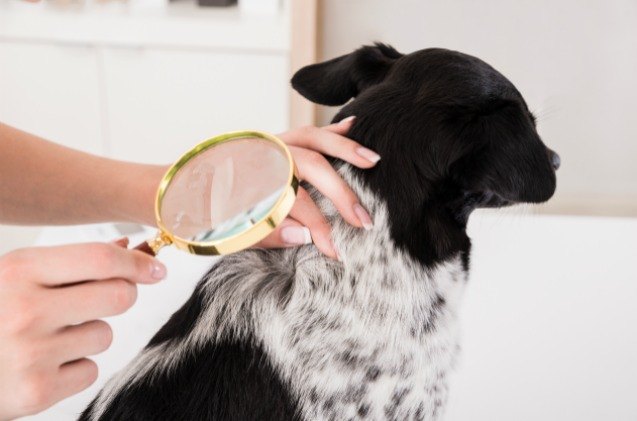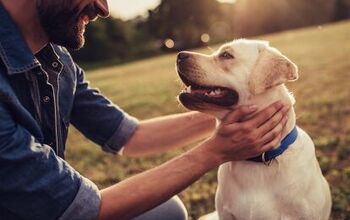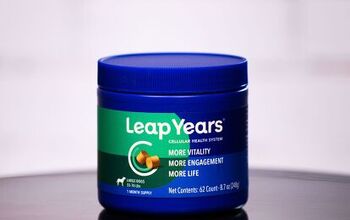Dog Lice: Everything You Need To Know To Protect Your Dog

Dog lice are not the same as the lice we find in humans, and thankfully, they are species-specific. Dog lice are flat and small, with six legs and no wings. They live in the feathers and hair of mammals and birds and they stay on their prey because they have hook-like claws that grasp tightly to the feathers or hair shafts of animals. They are wingless, and they can’t jump or fly.
Many people believe that their dogs may have fleas or tick bites when in actuality, it could be dog lice because dog lice are itchy and irritating to a dog’s skin in the same way. And like the human lice form, the nasty little insect is quite contagious and can bring inflammation, pain, hair loss and other long-term health impacts to your dog, so you want to be sure to rid your dog of them immediately.
There are two types of dog lice parasite. Their scientific names are Trichodectes canis or Heterodoxus spiniger (also called chewing lice) and Linognathus setosus (also called sucking lice). As their names imply, the chewing dog lice eat skin debris and the secretions of a dog’s skin while the sucking lice use pointed mouthlike tactics to crack your dog’s skin and feed on its blood.
The various types of lice bring itching and discomfort but also bring diseases and tapeworms, so remediating the situation as soon as you can is important for the spread and comfort of your dog.
If you notice your dog is itching and scratching or losing hair in places, you can look at his skin and see what’s going on. The dog lice are small, but just as you can typically with human lice, you’ll be able to see dog lice if you look closely at the shaft of their hair. They burrow in and are slow moving, and it’s easier to see sucking lice at any stage. Chewing lice are typically not seen until they reach the adult stage, so as soon as you notice them, you’ll want to begin treating the infestation.
You can also use a flea comb to help identify and spot, but if you don’t see any on the comb, look for other symptoms like skin redness, itching, hair loss, matted or dried fur or small wounds that look like ‘bug bites.’ It’s likely they are, and dogs who have dog lice go untreated can develop anemia. Sucking lice also take other nutrition and protein from your dog’s blood and sometimes, severe cases even require transfusions and supplements to replenish the blood.
Just as in humans and with human lice, being near another dog with an infestation is a main cause. This can occur in places where there are lots of dogs–parks, the vet office, kennels. Dog lice cannot jump, hop or fly and so specific contact has to happen for one dog to ‘give’ another dog lice.
Once the dog lice find a host, though, they hang out for a while, and much human lice–in stages. The egg, nymph and adult stages all cycle through in about a two-week time period, and that’s the approximate time in which you would most likely see symptoms manifest in your dog.
Dog Lice infestations are not terribly common in the domestic household dog and more often seen on older, stray, sick or feral dogs. Typically flea and tick preventatives given regularly will prevent your pet from getting dog lice, though they are not guarantees. If you do find dog lice on your dog, you’ll want to shave the dog’s hair so you can be sure you are getting rid of pockets of lice and can see where dog lice may have burrowed in and are harder to reach.
Topical treatments can be used to get rid of the infestation, and what is used varies on the severity of the infestation. Fipronil, Selamectin and Imidacloprid are commonly used, as is Permethrin. If treating your dog yourself, you’ll want to be careful as those insecticides are toxic to cats. Vulnerable dogs (pregnant or sick or young puppies) may also be affected differently by those treatments, so we always recommend you ask your veterinarian for the best way to go about treatment.
You may want to attack dog lice with a more natural approach. Many people first turn to flea and tick combs and much like handpicking nits out of human heads, a natural way to take lice out of dogs is to do the same. While it may be a bit more tedious and involve a bit more work (and repetition) on your part, it’s the only chemical-free way to remove dog lice. A basic comb like this can help bring the adults and some eggs to the surface, but know you’ll need to repeat the search regularly for about a month.
Some experts believe you can help bring the eggs that are attached to hair follicles to the surface better so that you can find them with the comb easier. They recommend rubbing mayonnaise into your dog’s hair and giving a little massage with your fingertips. The oil in the mayo will help loosen the eggs’ hold on the hair and you can comb out and then wash away eggs. When washing/shampooing, it’s suggested to use a good, organic citrus-based shampoo. Holistic vets like brands like Meridian with d-Limonene and Aloe to battle dog lice and act as a preventative for any return of the infestation. We also like Pawtitas Itch Soother as your pup most likely is itchy and scratchy (and may even have small wounds) and the Moringa and goldenseal in this blend from Pawtitas leave your pup soothed, clean and smelling amazing–all in an organic way.
Once you’ve bathed your dog, you can also use a do-it-yourself lemon rinse. It’s easy to make; simply take a few drops of organic lemon essential oil and combine with a couple of teaspoons of water in a spray bottle. The oil and water won’t mix, but the water will act as a transport for the lemon essential oil, and holistic practitioners have found this as an effective treatment for fleas and ticks, as well as dog lice eggs. Plus, your dog will smell delicious.
The most important thing to remember with natural treatments of dog lice is that you must be consistent. Consistent combing and picking, as well as shampooing out and rinsing (especially if you douse in mayonnaise) is what is needed for an effective natural treatment protocol. This means you should plan on doing this for at least 21 days, but you’ll want to be diligent as the amount of time dog lice stay can vary dog to dog.
The frustrating thing about treating for Dog Lice is that adults will lay eggs in different cycles and that means you have several different stages of dog lice life happening at once on your dog’s body. Multiple treatments are often what is needed because they’ll kill the nymphs and adults, but the waiting eggs will need a treatment of their own as they hatch.
It’s not uncommon for an infestation cycle to last for four-to-six weeks, and you’ll need to re-treat possibly a few times in that time frame. If you have more than one dog, even though you may not see signs, you’ll need to treat them all as well. In humans, if you see lice on one head of hair, there’s a good chance it is on another. Same goes for dogs, and you’ll want to be sure to take no chances with your other dogs.
The most important thing you can do to prevent dog lice from becoming a problem for your pups is to keep them as healthy and clean as they can be. Dog Lice tend to prey on dirtier (and less healthy) dogs so keeping them clean with regular bathing and grooming can go a long way. Probiotic shampoos are a great way to keep your dog’s coat healthy and oral probiotics are a great way to keep your dog’s immune system up (and their gut health in check). The best prevention is simply taking good care of your pet and its needs.
Still, Dog Lice infestations can happen, so be sure to wash everything your dog has come in contact with as best you can to cut down on the life cycle and reinfestation. This means you should not only clean all the bedding and stuffy toys your dog has come in contact with, but those that others (especially of the furry kind) may have come in contact with as well. A good, pet-safe detergent and as hot water as the materials will stand will go a long way in preventing another dog lice situation from occurring.

More by Lori Ennis
























